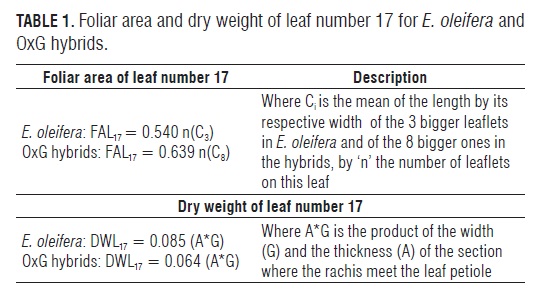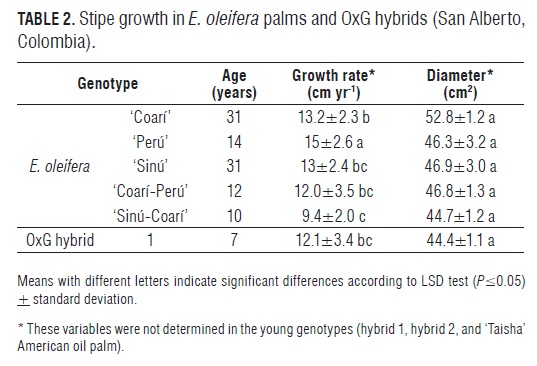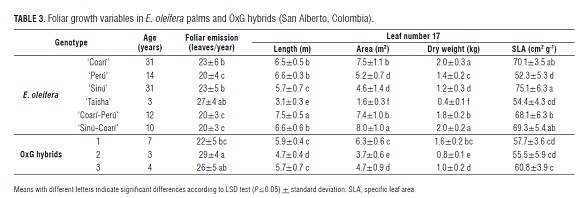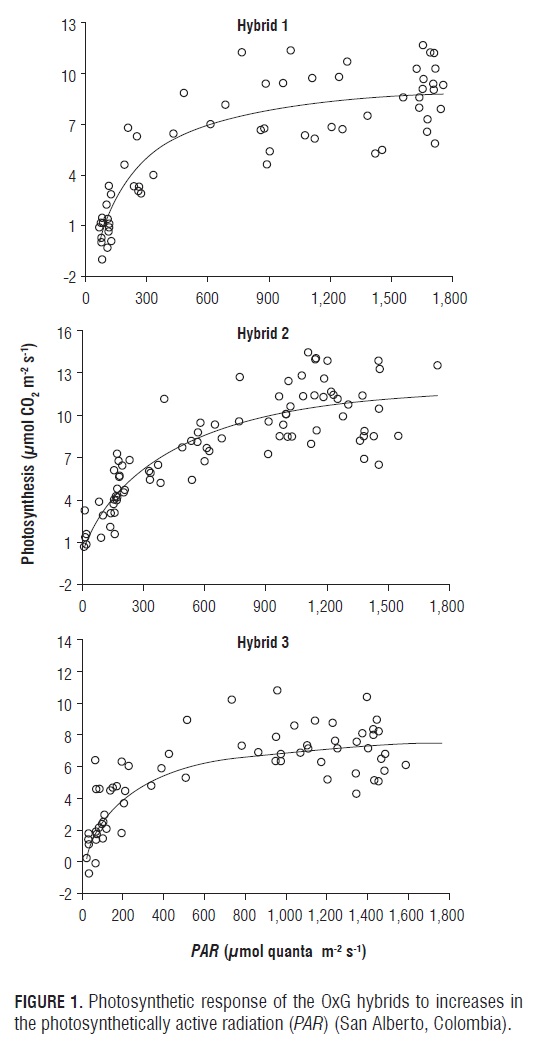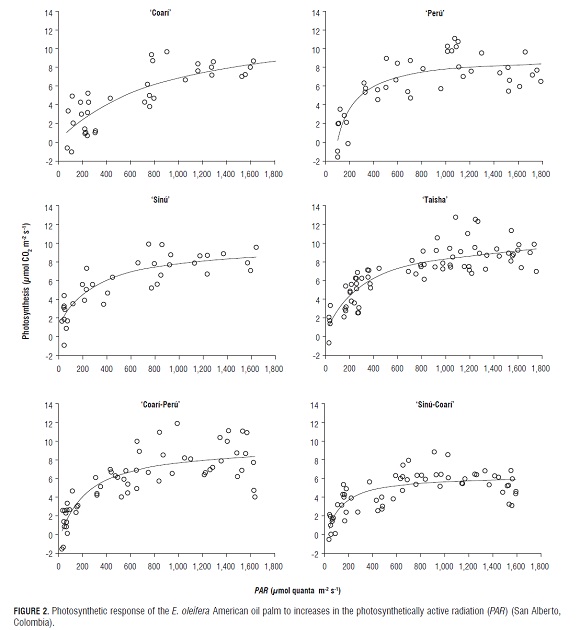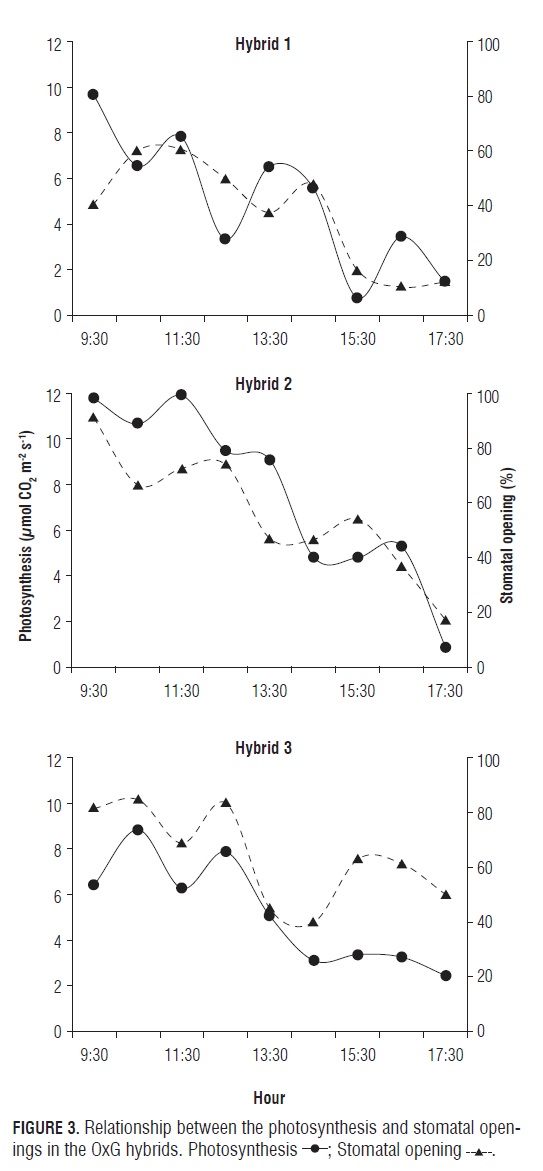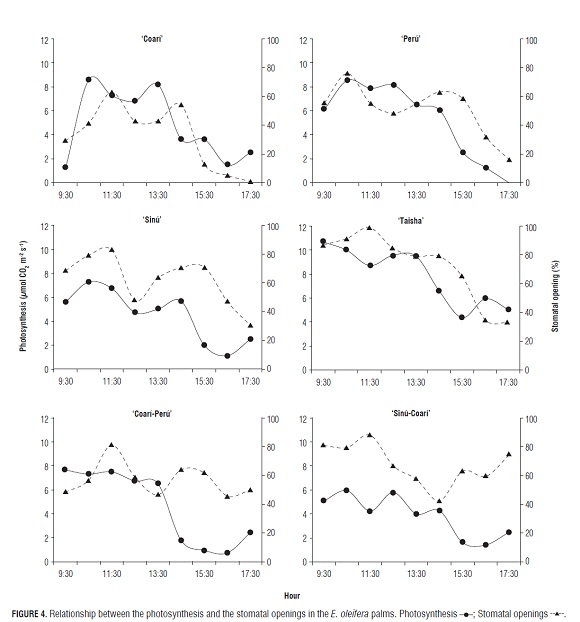Services on Demand
Journal
Article
Indicators
-
 Cited by SciELO
Cited by SciELO -
 Access statistics
Access statistics
Related links
-
 Cited by Google
Cited by Google -
 Similars in
SciELO
Similars in
SciELO -
 Similars in Google
Similars in Google
Share
Agronomía Colombiana
Print version ISSN 0120-9965
Agron. colomb. vol.31 no.3 Bogotá Sept./Dec. 2013
CROP PHYSIOLOGY
Physiological and morphological characterization of american oil palms (Elaeis oleifera HBK Cortes) and their hybrids (Elaeis oleifera × Elaeis guineensis) on the Indupalma plantation
Caracterización fisiológica y morfológica de palmas americanas de aceite (Elaeis oleifera HBK Cortés) y sus híbridos (Elaeis oleifera × Elaeis guineensis) de la plantación Indupalma
Yurany Dayanna Rivera M.1, Daniel Gerardo Cayón S.2 and Jesús Edgardo López M.3
1Program of Biology and Plant Breeding, Corporación Centro de Investigación en Palma de Aceite (Cenipalma). Barrancabermeja (Colombia). dgcayons@unal.edu.co2Department of Agronomy, Faculty of Agricultural Sciences, Universidad Nacional de Colombia. Bogota (Colombia).
3Department of Agriculture, Indupalma. San Alberto (Colombia).
Received for publication: 26 August, 2013. Accepted for publication: 1 November, 2013.
ABSTRACT
The morphological and photosynthetic activity were characterized in six genotypes of American oil palm (E. oleifera) of different origins and three of their OxG hybrids (E. oleifera × E. guineensis) with a completely randomized experimental design, three replications and 16 palms per replication. Determinations were made for: photosynthesis, internal CO2 concentration, chlorophyll content, stomatal openings and density, specific leaf area, and measurements of vegetative growth. The genotypes were differentiated by growth rate, emission, area and dry weight of the leaves. The stomatal openings of all the genotypes were maximum in the morning hours, with partial closures at midday; therefore, the maximum rate of photosynthesis was between 9:00 and 12:00 hr. The "Perú" American oil palm and "hybrid 2" (Sinú-Coarí × La Mé) showed higher CO2 internal concentrations, total chlorophyll contents, light saturation points and photosynthetic rates, even with low levels of photosynthetically active radiation; characteristics that indicate a high capacity for the fixation of CO2. The photosynthetic rate showed a high positive correlation with the chlorophyll content and a negative correlation with the specific leaf area. In conclusion, the "Perú" American oil palm showed relevant characteristics for use in breeding programs as female parent of OxG hybrids, while "hybrid 2", due to its outstanding morphophysiological characteristics, is considered a genotype with good agronomic performance.
Key words: growth, chlorophyll content, plant breeding, photosynthesis, stomata.
RESUMEN
Se caracterizó la actividad fotosintética y la morfología de seis genotipos de palma americana de aceite (Elaeis oleifera) de orígenes diferentes y tres de sus híbridos interespecíficos OxG (E. oleifera × E. guineensis), en un diseño experimental completamente al azar, con tres repeticiones, y 16 palmas por repetición. Se hicieron determinaciones de fotosíntesis, concentración interna de CO2, contenido de clorofila, densidad y apertura estomática, área foliar específica y medidas vegetativas de crecimiento. Los genotipos se diferenciaron en tasa de crecimiento, y emisión, área y peso seco de hojas. La apertura estomática de todos los genotipos fue máxima en horas de la mañana, con un cierre parcial al mediodía, y por tanto la máxima tasa fotosintética se presentó entre las 9:00 y 12:00 hr. La palma americana "Perú" y "el híbrido 2" (Sinú-Coarí × La Mé) registraron mayores concentraciones internas de CO2 y contenido de clorofila, puntos de saturación lumínica y tasas fotosintéticas más altas, aún con niveles bajos de radiación fotosinteticamente activa, características que indican mayor capacidad para la fijación de CO2. La tasa fotosintética mostró una alta correlación positiva con el contenido de clorofila, y negativa con el área foliar. En conclusión, la palma americana "Perú" presentó características relevantes para ser aprovechadas en un programa de mejoramiento como parental femenino de híbridos OxG, mientras el "híbrido 2", por sus sobresalientes características morfofisiológicas puede considerarse un genotipo con un buen desempeño agronómico.
Palabras clave: contenido de clorofila, crecimiento, estomas, fitomejoramiento, fotosíntesis.
Introduction
The genus Elaeis has two species of economic importance for the oil palm agro-industry around the world: Elaeis guineensis, native to Central and Western Africa, and Elaeis oleifera, native to the Americas (Rey et al., 2004).
The most important difference between these two species lies in the formation of the bunches; E. oleifera shows a high percentage of parthenocarpic fruits due to pollination difficulties and, therefore, its ratio of normal fruit per bunch is approximately 30 - 45% (Corley and Tinker, 2003).
However, E. oleifera constitutes a strategic genetic resource for global oil palm development as a source of remarkable morphological and physiological characteristics: its adaptation to ecosystems that are normally marginalized by E. guineensis, its ability to be harvested over a long period of time due to its slow height growth (10 - 15 cm per year), its tolerance to pests and diseases common to E. guineensis, its oil with a high content of unsaturated fatty acids, its appreciable quantities of carotenes and vitamin E, and its ability to produce fertile hybrids with E. guineensis with intermediate characteristics of these two species and hybrid vigor for some traits of agronomic interest (Le Guen et al., 1993; Rey et al., 2003, 2004; Rocha et al., 2006). Thus, the interspecific OxG hybrid has a lot of potential to improve the competitiveness and sustainability of the crop, mainly due to its partial resistance to the bud rot disease, which is perhaps the greatest threat to the oil palm industry in the Americas (Torres et al., 2010), and its high productivity, 28-33 t of fresh fruit bunches/ha per year with an oil extraction rate between 18 and 19% (Corley and Tinker, 2003).
The biological basis for increasing productivity includes the maximization of the physiological processes that regulate and intervene directly in the oil palm production, for which an increase in the capacity of the palms to capture solar energy, its converting into carbohydrates and the efficient allocation of photoassimilates towards the bunches, are a priority (Cayón, 1998; Corley and Tinker, 2003). In Colombia, few studies have been directed toward research on the morphological and physiological behavior of oil palm genotypes; furthermore, subjects such as photosynthesis, transpiration and environmental factors affecting morpho-physiological processes have been little explored. These studies are potential tools for the rapid selection of highly productive oil palm genotypes (Sterling, 1993) in a way in which differences in physiological behavior can be used as practical and efficient criteria for the selection and improvement of genetic materials (Ayala and Gómez, 2000). The objective of this study was to carry out a comparative characterization of the phenotype and the photosynthetic performance of six parental genotypes of the American oil palm (E. oleifera) from different origins and three of their OxG hybrids on the Indupalma plantation (San Alberto, Cesar, Colombia).
Material and methods
The study was carried out on the Indupalma plantation, located in the municipality of San Alberto (Colombia) at an altitude of 125 m a.s.l., with a maximum temperature of 34ºC and a minimum temperature of 22ºC, relative humidity of 72%, annual precipitation of 2,497 mm, annual evaporation of 1,208 mm and 2,130 h of solar radiation per year; agroecological conditions that correspond to a Tropical Moist Forest life zone (TM F, Holdridge).
Nine genotypes were compared: six American oil palm (E. oleifera): "Coarí", "Perú", "Sinú", "Taisha", "Coarí-Perú", and "Sinú-Coarí"; and three of their OxG hybrids formed by crosses between some of these American oil palm and "La Mé" origin pollen: hibrid 1 (Coarí-Perú × La Mé), hybrid 2 (Sinú-Coarí × La Mé), and hybrid 3 (Coarí × La Mé). The "Taisha", hybrid 1, and hybrid 2 were the only young genotypes (3 years); the others were mature, more than 6-years-old. A completely randomized experimental design was used with three replications and 16 palms per replication. Determinations of photosynthetic rate, internal CO2 concentration, total chlorophyll content, stomatal area and density, stomatal opening, and vegetative growth (growth rate, stipe diameter, foliar emission, area and dry weight of leaf number 17, and specific leaf area) were made.
The photosynthetic rate and the internal CO2 concentration were determined by measuring the central leaflets of leaf number 17 with the portable photosynthesis system LI- 6200 (LICOR, Lincoln, NE ), during two periods of the year with different photosynthetically active radiation (PAR) conditions. Daily curves of the photosynthetic response to the PAR intensity were formed between 7:30 and 17:30 hr and were fitted with the analytical software Statistix® v9.0 to a Michaelis Menten hyperbolic model:
where, An is the rate of net photosynthesis (µmol CO2 m-2 s-1); Amax is the irradiance-saturated rate of gross photosynthesis (µmol CO2 m-2 s-1); b is ½ of saturating PAR (µmol photon m-2 s-1), and Rd is the dark respiration rate (µmol CO2 m-2 s-1), corresponding to the value of An when PAR = 0 (µmol photon m-2 s-1) (Rivera et al., 2012). The total chlorophyll content was determined by the acetone extraction method (Flórez and Cruz, 2004) with 0.8 cm2 foliar discs extracted from the center of the utilized leaflets for the measurement of photosynthesis.
The stomatal area and density and daily stomatal opening were determined by microscopic observations at a 40x magnification of the impressions with transparent enamel on the back of the central leaflets of leaf number 17, according to Flórez and Cruz (2004).
The growth rate, stipe diameter, foliar emission, and length of leaf number 17 were determined with the formulas proposed by Corley and Tinker (2003). The growth rate was equal to the ratio between the height and age of the palm, where the height was the stipe length from ground level to the bottom of leaf number 33. The stipe diameter was estimated from the height:
The foliar emission was the amount of new leaves produced from leaf number 1 during a period of time. The sum of rachis length and petiole length was the total length of leaf number 17. The specific leaf area (SLA) was estimated by taking two central leaflets of each side of leaf number 17; in each one, a central section 10 cm in length was cut. Afterwards, the sections were dried in an oven at 85°C for 24 h, until constant dry weight. The SLA was calculated by dividing the areas of the foliar segments by their dry weight. The foliar area of leaf number 17 (FAL17) and the dry weight of leaf number 17 (DWH17) were calculated with the formulas developed by Contreras et al. (1999) for E. oleifera and OxG hybrids (Tab. 1).
The generated data were subjected to an analysis of variance and the mean comparison was done by the least significant difference test (LSD ), using the SAS® statistical software v9.0 (SAS Institute, Cary, NC ).
Results and discussion
Stipe
It is important to note that, since the rate of growth of the stipe in E. oleifera and in the OxG hybrids is low during the first 4 years (after transplant) and increases and remains constant from the 6 years (Corley and Tinker, 2003), the height, diameter and growth rate were not determined in the young genotypes, less than 6 years-old (hybrid 1, hybrid 2, and "Taisha"). The stipes of the older American oil palms ("Coarí" and "Sinú") showed a decumbent growth. The growth rate was different (P=0,05) among the genotypes over 7 years (Tab. 2); hybrid 1 showed a rate of 12 cm per year; for E. oleifera, the "Perú" registered the highest rate and "Sinú-Coarí" the lowest. The stipe diameter did not vary significantly between the genotypes despite the difference in ages. Therefore, this variable assumed the characteristics of a constant in the comparison tests with genetic materials (Corley and Tinker, 2003).
Leaves
The foliar growth variables showed statistically significant differences (P≤0.05) among all the genotypes (Tab. 3). However, the analysis was performed for genotypes that were over 7 years because total biomass increases with the age of oil palms and, from 7 to 10 years in age, the foliar variables (area, emission and dry weight) are kept at a constant rate (Corley and Tinker, 2003). That is, young genotypes obtained lower values of leaf growth due to their young age (less than 7 years old).
The foliar emission was higher in the young palms (hybrid 1, hybrid 2, and the "Taisha") than in the other genotypes. The "Sinú-Coarí" showed the highest area for leaf number 17, mainly due to its wider and longer leaflets, in comparison with leaf number 17 of the "Sinú", which had the smallest and the lowest number of leaflets. Leaf number 17 of the "Sinú-Coarí" was the longest and showed the highest number of leaflets, although its area was not the biggest. The "Coarí" and "Sinú-Coarí" presented the higher dry weights for leaf number 17. The specific leaf area (SLA) was higher in the "Sinú" and "Sinú-Coarí" and lower in the "Perú" and the young OxG hybrids.
This can be explained by the fact that the number of new leaves produced by palms is low in the first year after transplant, high for the second and third years after transplant, and then decreases at a constant rate with age, stabilizing at between 8 and 12 years of age with around 20 to 25 leaves/year (Corley and Tinker, 2003) or less in the summer periods (Torres et al., 2004; Zambrano, 2004). The values obtained for leaf area were within the range reported by Corley and Tinker (2003) for E. oleifera and OxG palms. On the other hand, the foliar area is directly related to the growth and yield of oil palms and other crops (Awal et al., 2004; Cayón, 1998; Xu and Shen, 2002); but, Vallejo (1976) indicated that an increase in the foliar area of E. oleifera caused a significant increase in bunch weights but a decrease in the proportion of fruits; so, a higher foliar area, as in the "Sinú-Coarí", does not always indicate a good yield. Additionally, the same genotype showed the highest quantity of foliar area per unit of foliar weight (Pedraza and Cayón, 2010; Peláez et. al, 2010), which can be attributed to alterations in the anatomical morphological structures of the leaves with a decrease in the concentration of nutrients and the dry weight (Ayala and Gómez, 2000). Therefore, the SLA reduction seen in hybrid 1, hybrid 2, and the "Perú" indicates that their leaves have a thicker mesophyll due to the higher number and size of layers of palisade cells (Rodríguez and Cayón, 2008), which suggests that the amount of photoassimilates in these leaves is greater (Ayala and Gómez, 2000). Finally, the high production of leaves in hybrid 2 could determine a high yield of bunches in the short-term because each leaf corresponds to an inflorescence whose size and development depend on the plant"s physiological state (Hormaza et al., 2012). In other words, this genotype is probably more efficient in terms of physiological behavior due to its capacity for growth as a consequence of the photosynthetic activity and the absorption of nutrients by the roots (Coto et al., 2002).
Photosynthetic and stomatal variables
Figures 1 and 2 show the photosynthetic response of the genotypes to the PAR. All the responses form a curve where the photosynthetic rates were lower for low PAR intensities and progressively increased with increases in the PAR until reaching the maximum values. The photosynthetic rates were within the intervals reported by Peláez et al. (2010) for E. oleifera (6-13 µmol CO2 m-2 s-1) and hybrids (2 - 12 µmol CO2 m-2 s-1). Hybrid 1, hybrid 2, and the "Coarí" and "Perú" presented the higher photosynthetic rates; however, only hybrid 2 and the "Perú" registered the maximum photosynthetic rate at high intensities of radiation and maintained it over a broad range of the PAR. So, these genotypes have a better adaptation to high radiation because they demonstrated higher rates of CO2 assimilation with high levels of light saturation
Table 4 shows the maximum photosynthesis, light saturation point (LSP ), internal CO2 concentration (Ci) and total chlorophyll content in the leaves. The LSP , or saturating PAR, was significantly higher in the "Perú" and in hybrid 2, with high values for the photosynthetic rate; meanwhile, the "Coarí" and hybrid 1 demonstrated an elevated photosynthetic rate but were quickly saturated (at a lower PAR). The reduction of the photosynthetic rate in conditions of high solar radiation is due to the sudden blockage of the photosynthetic apparatus by the elevation of the foliar temperature, which causes an elevation in the internal CO2 concentration in the mesophyll, impeding the exchange of gases in the leaves. This likely suggests that the "Perú" and hybrid 2 have a photosynthetic system that is more resistant to high air temperatures, thereby allowing for the assimilation of CO2 for longer periods of time on sunny days and, therefore, they would have a higher biomass production due to a higher production that is achieved with a higher number of leaves exposed to moderate levels of radiation rather than few leaves exposed to intense illumination (Cayón, 1998).
The Ci was statistically higher in the "Perú" and in hybrid 2, which also exhibited a higher photosynthesis; meanwhile, in the other genotypes, a lower Ci coincided with lower photosynthetic rates. A decline in Ci indicates that the principal cause of the reduction in the photosynthetic rate is a reduction in stomatal conductance; meanwhile, an increase in the Ci suggests that a decrease in the photosynthetic activity of the mesophyll cells (a non-stomatal factor) is the principal cause of photosynthetic rate reductions (Ainsworth and Rogers, 2007; Xu and Shen, 2002). The association between a high Ci and the photosynthesis of the "Perú" and hybrid 2 could indicate that these genotypes have a high capacity for the fixation of CO2 when concentrating a high quantity of carbon dioxide in the foliar mesophyll.
The total chlorophyll content in the leaves was significantly higher in hybrid 2 and in the "Perú" and "Taisha"; however, only the first two genotypes also showed high photosynthetic rates, confirming that photosynthesis depends on the concentration of chlorophyll and the ontogeny of the leaves (Arenas et al., 2004; Cayón, 2001; Gratani et al., 1998; Reyes et al., 2000). These results are different to those reported by Peláez et al. (2010), which showed that E. oleifera leaves with high photosynthesis had low chlorophyll contents.
The stomatal variables were statistically different among the genotypes (Tab. 5). In general, the OxG hybrids showed bigger stomata and a higher stomatal density than the E. oleifera palms. Hybrid 2 had the biggest stomata (the highest stomatal area) and hybrid 3 stood out for its stomatal density. In a similar study (Peláez et al., 2010), the stomatal density of OxG hybrids was similar to that of E. oleifera. A higher density and a better distribution of stomata in the leaves guarantee higher water use efficiency, so it is expected that hybrid 2 and hybrid 3 would have a good hydraulic relationship and a very efficient mechanism of drought tolerance.
Figures 3 and 4 show the relationship between the photosynthetic rate and the daily stomatal opening in the genotypes. The curve for the stomatal openings in all genotypes presented two maximum points, the highest in the morning hours (between 9:00 and 11:00 hr) and the lowest in the middle of the afternoon (between 14:00 and 15:00 hr), with a partial closure at midday. Between 6:00 and 7:30 hr, the majority of the stomata were closed, then the opening process was rapid until reaching the highest percentage of open stomata between 10:00 and 12:00 hr. Due to the increase in the air and foliar temperatures and the decrease in the relative humidity at midday (between 12:00 and 13:30 hr), there was partial closure in the stomata, suggesting that total restriction for the exchange of gases does not exist. Afterwards, the stomata began to open again until 15:30 hr; then, their closure progressed until 17:30 hr. Although the E. oleifera palms and the OxG hybrids kept similar proportions of open stomata in the morning hours, the OxG hybrids maintained them for a longer period of time (2-3 h), but, at the peak of stomatal closures (17:30 hr), the E. oleifera palms maintained more open stomata than the OxG hybrids.
This stomatal behavior has been reported by various authors (Cayón, 1998; Corley and Tinker, 2003; Peláez et al., 2010) and indicates that a correlation exists between the stomatal opening, the soil moisture, the relative humidity, and the air temperature. So, in the morning hours, the higher degree of stomatal opening is due to the presence of low temperatures and high relative humidity; at midday, stomatal closure is caused by the increase in the air temperature and the decrease in the soil moisture and the relative humidity, which avoids excessive transpiration and conserves maximum cellular turgency; at the end of the afternoon, fluctuations in the stomatal closure is mainly due to the rapid increase in the air and foliar temperature. On the same note, Cayón (1998) indicated that the stomatal opening and closing in the oil palm during the day are more related to the daily variations in air temperature and soil moisture.
Since the stomata have an essential function in maintaining the homeostasis of the plant, especially in the regulation of the transpiration and the intake of CO2 required by photosynthesis (Chaimsohn et al., 2008), the stomatal behavior displayed by hybrid 2 allowed it to have a longer photosynthetic process during the day, to keep a good transport system for the nutrients absorbed by the roots, that is, for their mobility through the transpiration current, and to reduce the water lost through excessive transpiration, conditions that contribute to an increase in the productivity of this genotype.
Conclusions
The significant correlation between the photosynthetic rates, stomatal behavior and some variables of vegetative growth of the oil palm genotypes (E. oleifera and OxG hybrids) indicates that the physiological and morphological characterization is a very important tool in the selection process of genotypes with promising traits. Within this characterization, the photosynthetic rate has the advantage of being able to be used at different stages, allowing for comparisons in early stages of growth (if done on leaves of the same age), even including the nursery stage, and, thereby, the selection of advance genotypes that are photosynthetically more efficient. However, the characterization of vegetative growth in oil palms should be done when the palms are adults (= 7 years-old), in order to not only optimize the resources (human, financial or temporary) and to facilitate the measurements, but also to avoid the direct effect of age and to determine differences due to genotypes with a degree of certainty (treatments).
The "Perú" presented relevant characteristics for use in breeding programs as female parent of OxG hybrids, such as high CO2 internal concentrations, total chlorophyll contents, light saturation points, and photosynthetic rates, even with low levels of photosynthetically active radiation. Furthermore, hybrid 2 (Sinú-Coarí × La Mé), due to its outstanding morphophysiological characteristics such as a high production of leaves, a suitable regulation of transpiration, a high capacity for the fixation of CO2 and, thereby, a high amount of photoassimilates in these leaves per unit of weight, is considered a genotype with a good agronomic performance in terms of biomass production, yield of bunches and mechanism of drought tolerance.
Acknowledgements
The authors wish to thank the managerial and operational personal of Indupalma for permitting the development of this research and Rafael Cruz (Universidad Nacional de Colombia, Bogotá) for technical assistance in the laboratory procedures and the management of the equipment.
Literature cited
Ainsworth, E. and A. Rogers. 2007. The response of photosynthesis and stomatal conductance to rising [CO2]: mechanisms and environmental interactions. Plant Cell Environ. 30(3), 258-270. [ Links ]
Arenas, J., G. Cayón, and O. Agudelo. 2004. Respuestas fisiológicas y acumulación de materia seca de genotipos de soya en el Valle del Cauca. Fitotec. Colomb. 4(2), 20-26. [ Links ]
Awal, M., I. Wan, J. Endan, and M. Haniff. 2004. Regression model for computing leaf area and assessment of total leaf area variation with frond ages in oil palm. Asian J. Plant Sci. 3(5), 642-646. [ Links ]
Ayala, I. and P. Gómez. 2000. Identificación de variables morfológicas y fisiológica asociadas con el rendimiento en materiales de palma de aceite (Elaeis guineensis Jacq.). Palmas 21(4), 10-21. [ Links ]
Cayón, G. 1998. Ecofisiología de la palma de aceite (Elaeis guineensis Jacq.). pp. 38-54. In: Memorias, Primer Curso Internacional de palma de aceite. Cenipalma, Bogota. [ Links ]
Cayón, G. 2001. Evolución de la fotosíntesis, transpiración y clorofila durante el desarrollo de la hoja de plátano (Musa AAB Simmonds). InfoMusa 10(1), 12-15. [ Links ]
Chaimsohn, F., M. Montiel, E. Villalobos, and J. Mora. 2008. Anatomía micrográfica del folíolo de la palma neotropical Bactris gasipaes (Arecaceae). Biol. Trop. 56(2), 952-959. [ Links ]
Contreras, A., O. Martínez, G. Cayón, and R. Corchuelo. 1999. Estimación del área y del peso seco foliar en Elaeis guineensis, Elaeis oleifera y el híbrido interespecífico Elaeis guineensis x Elaeis oleifera. Agron. Colomb. 16(1-3), 24-29. [ Links ]
Corley, R. and P. Tinker. 2003. The oil palm. 4th ed. Blackwell Science, Oxford, UK. [ Links ]
Coto, E., C. Chinchilla, J. Bulgarlli, and T. Palma. 2002. Crecimiento vegetativo en previvero de cinco cruces comerciales de palma aceitera (Elaeis guinensis Jacq). ASD Oil Palm Papers 23, 14-19. [ Links ]
Flórez, V. and R. Cruz. 2004. Guías de laboratorio de fisiología vegetal. Universidad Nacional de Colombia, Bogota. [ Links ]
Gratani, I., P. Pesoli, and M. Crescente. 1998. Relationship between photosynthetic activity and chlorophyll in an isolated Quercus ilex L. tree during the year. Photosynthetica 35(3), 445-54. [ Links ]
Hormaza, P., E. Fuquen, and H. Romero. 2012. Phenology of the oil palm interspecific hybrid Elaeis oleifera × Elaeis guineensis. Sci. Agric. 69(4), 275-280. [ Links ]
Le Guen, V., P. Amblard, A. Omore, A. Koutonou, and J. Meunier. 1993. Programa del IRHO con híbridos interespecíficos Elaeis oleifera x Elaeis guineensis. Palmas 14(4), 63-70. [ Links ]
Pedraza, E. and G. Cayón. 2010. Caracterización morfofisiológica de Jatropha curcas L. variedad Brasil cultivada en dos zonas de Colombia. Acta Agron. 59(1), 30-36. [ Links ]
Peláez, E., D. Ramírez, and G. Cayón. 2010. Fisiología comparada de palmas africana (Elaeis guineensis Jacq.), americana (Elaeis oleifera H.B.K. Cortés) e híbridos (Elaeis oleifera x Elaeis guineensis) en Hacienda La Cabaña. Palmas 31(2), 29-38. [ Links ]
Rey, L., I. Ayala, W. Delgado, and P. Rocha. 2003. Colecta de material genético de la palma americana Nolí (Elaeis oleifera (H.B.K.) Cortez) en el trapecio amazónico. Ceniavances 101(1), 1-4. [ Links ]
Rey, L., P. Gómez, I. Ayala, W. Delgado, and P. Rocha. 2004. Colecciones genéticas de palma de aceite Elaeis guineensis (Jacq.) y Elaeis oleifera (H.B.K.) de Cenipalma: Características de importancia para el sector palmicultor. Palmas 25(4), 39-48. [ Links ]
Reyes, M., A. Villegas, M. Colinas, and G. Calderón. 2000. Peso específico, contenido de proteína y de clorofila en hojas de naranjo y tangerino. Agrociencia 34(1), 49-55. [ Links ]
Rivera, Y., L. Moreno, C. Bayona, and H. Romero. 2012. Physiological response of oil palm interspecific hybrids (Elaeis oleifera H.B.K. Cortes versus Elaeis guineensis Jacq.) to water deficit. Braz. J. Plant Physiol. 24(4), 273-280. [ Links ]
Rocha, P., F. Prada, L. Rey, and I. Ayala. 2006. Caracterización bioquímica parcial de la colección de Elaeis oleifera de Cenipalma proveniente de la Amazonía colombiana. Palmas 27(3), 35-44. [ Links ]
Rodríguez, P. and G. Cayón. 2008. Efecto de Mycosphaerella fijiensis sobre la fisiología de la hoja de banano. Agron. Colomb. 26(2), 256-265. [ Links ]
Sterling, F. 1993. Modelo de selección y mejoramiento de PIPA/ASD : objetivos y necesidades del palmicultor del futuro. Palmas 14(4), 26-39. [ Links ]
Torres, M., L. Rey, F. Gelves, and L. Santacruz. 2004. Evaluación del comportamiento de los híbridos interespecíficos Elaeis oleifera x Elaeis guineensis en la plantación Guaicaramo S.A. Palmas 25(4), 351-57. [ Links ]
Torres, G, G. Sarria, F. Varon, M. Coffey, M. Elliot, and G. Martinez. 2010. First report of bud rot caused by Phytophthora palmivora on African oil palm in Colombia. Plant Dis. 94(9), 1,163.1 Vallejo, [ Links ] G. 1976. Estudio de poblaciones espontáneas de la palma Nolí Elaeis oleifera en Colombia. M.Sc. thesis. Programa de Estudios para Graduados (PE G), Universidad Nacional de Colombia, Bogota. [ Links ]
Xu, D. and Y. Shen. 2002. Photosynthetic efficiency and crop yield. pp. 821-834. In: Pessarakli, M. (ed.). Handbook of plant and crop physiology. Marcel Dekker, New York, NY. [ Links ]
Zambrano, J. 2004. Híbridos interespecíficos Elaeis oleifera x Elaeis guineensis: Una alternativa de renovación para la zona oriental de Colombia. Palmas 25(4), 339-349. [ Links ]















